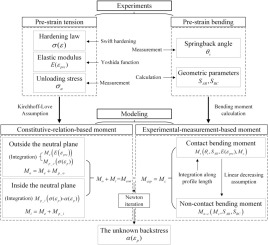当前位置:
X-MOL 学术
›
J. Mater. Process. Tech.
›
论文详情
Our official English website, www.x-mol.net, welcomes your
feedback! (Note: you will need to create a separate account there.)
Characterizing the back stress of ultra-thin metallic sheet via pre-strain tension/bending process
Journal of Materials Processing Technology ( IF 6.7 ) Pub Date : 2020-05-01 , DOI: 10.1016/j.jmatprotec.2019.116560 Rui Zhang , Zhutian Xu , Yujun Deng , Linfa Peng
Journal of Materials Processing Technology ( IF 6.7 ) Pub Date : 2020-05-01 , DOI: 10.1016/j.jmatprotec.2019.116560 Rui Zhang , Zhutian Xu , Yujun Deng , Linfa Peng

|
Abstract The buckling and instability of the ultra-thin sheet metal specimens subjected to compressive loading present an evident difficulty for the investigation of Bauschinger effect by using traditional tensile-compressive loading tests. In that regard, a pre-strain/bending method which is easier to implement was developed to characterize the back stress of ultra-thin metallic sheets. SS 316 L sheet specimens with the thickness of 0.1 mm were first subjected to uniaxial tension for a specific pre-strain. After that, they were bent at different radius levels to achieve different compression conditions. By calculating bending moments based on experiments and constitutive relationship respectively, the back stress which presented the offset stress between the stress-strain curves of loading and reverse loading, could be obtained through iteration according to the equivalence of above two moments. Experimental results indicated that the softening caused by Bauschinger effect led to evident increase of back stress when increasing the pre-strain. By utilizing the experiment and calculation method developed in this study, parameter identification of back stress evolution for ultra-thin metallic sheet can be realized practically and the relationship between the back stress, pre-strain along with reverse plastic strain could be established and analyzed. The presented method was thus proved to be an efficient solution for characterizing the back stress of ultra-thin metallic sheets.
中文翻译:

通过预应变拉伸/弯曲过程表征超薄金属板的背应力
摘要 超薄金属板试样在压缩载荷作用下的屈曲和不稳定性给传统的拉压载荷试验研究包辛格效应带来了明显的困难。在这方面,开发了一种更容易实施的预应变/弯曲方法来表征超薄金属板的背应力。厚度为 0.1 mm 的 SS 316 L 板材试样首先经受单轴拉伸以获得特定的预应变。之后,它们以不同的半径水平弯曲以达到不同的压缩条件。通过分别基于实验和本构关系计算弯矩,得到加载和反向加载应力-应变曲线之间呈现偏移应力的背应力,根据上述两个矩的等价性,可以通过迭代得到。实验结果表明,随着预应变的增加,包辛格效应引起的软化导致背应力明显增加。利用本研究开发的实验和计算方法,可以实际实现超薄金属板背应力演化的参数识别,并可以建立和分析背应力、预应变和反向塑性应变之间的关系。因此,所提出的方法被证明是表征超薄金属板背应力的有效解决方案。实验结果表明,随着预应变的增加,包辛格效应引起的软化导致背应力明显增加。利用本研究开发的实验和计算方法,可以实际实现超薄金属板背应力演化的参数识别,并可以建立和分析背应力、预应变和反向塑性应变之间的关系。因此,所提出的方法被证明是表征超薄金属板背应力的有效解决方案。实验结果表明,随着预应变的增加,包辛格效应引起的软化导致背应力明显增加。利用本研究开发的实验和计算方法,可以实际实现超薄金属板背应力演化的参数识别,并可以建立和分析背应力、预应变和反向塑性应变之间的关系。因此,所提出的方法被证明是表征超薄金属板背应力的有效解决方案。可以建立和分析预应变和反向塑性应变。因此,所提出的方法被证明是表征超薄金属板背应力的有效解决方案。可以建立和分析预应变和反向塑性应变。因此,所提出的方法被证明是表征超薄金属板背应力的有效解决方案。
更新日期:2020-05-01
中文翻译:

通过预应变拉伸/弯曲过程表征超薄金属板的背应力
摘要 超薄金属板试样在压缩载荷作用下的屈曲和不稳定性给传统的拉压载荷试验研究包辛格效应带来了明显的困难。在这方面,开发了一种更容易实施的预应变/弯曲方法来表征超薄金属板的背应力。厚度为 0.1 mm 的 SS 316 L 板材试样首先经受单轴拉伸以获得特定的预应变。之后,它们以不同的半径水平弯曲以达到不同的压缩条件。通过分别基于实验和本构关系计算弯矩,得到加载和反向加载应力-应变曲线之间呈现偏移应力的背应力,根据上述两个矩的等价性,可以通过迭代得到。实验结果表明,随着预应变的增加,包辛格效应引起的软化导致背应力明显增加。利用本研究开发的实验和计算方法,可以实际实现超薄金属板背应力演化的参数识别,并可以建立和分析背应力、预应变和反向塑性应变之间的关系。因此,所提出的方法被证明是表征超薄金属板背应力的有效解决方案。实验结果表明,随着预应变的增加,包辛格效应引起的软化导致背应力明显增加。利用本研究开发的实验和计算方法,可以实际实现超薄金属板背应力演化的参数识别,并可以建立和分析背应力、预应变和反向塑性应变之间的关系。因此,所提出的方法被证明是表征超薄金属板背应力的有效解决方案。实验结果表明,随着预应变的增加,包辛格效应引起的软化导致背应力明显增加。利用本研究开发的实验和计算方法,可以实际实现超薄金属板背应力演化的参数识别,并可以建立和分析背应力、预应变和反向塑性应变之间的关系。因此,所提出的方法被证明是表征超薄金属板背应力的有效解决方案。可以建立和分析预应变和反向塑性应变。因此,所提出的方法被证明是表征超薄金属板背应力的有效解决方案。可以建立和分析预应变和反向塑性应变。因此,所提出的方法被证明是表征超薄金属板背应力的有效解决方案。











































 京公网安备 11010802027423号
京公网安备 11010802027423号